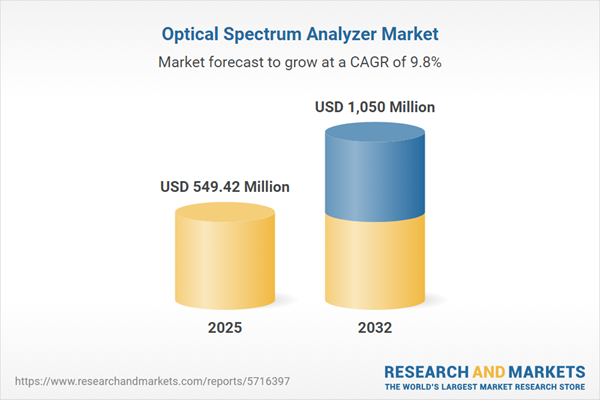Speak directly to the analyst to clarify any post sales queries you may have.
The optical spectrum analyzer market is at a pivotal stage, delivering innovative measurement capabilities that help senior leaders navigate rising technical complexity, evolving regulatory expectations, and critical operational demands in global photonics sectors.
Market Snapshot: Growth Trajectory in the Optical Spectrum Analyzer Market
The optical spectrum analyzer market is projected to increase from USD 500.66 million in 2024 to USD 549.42 million by 2025, with expectations to reach USD 1.05 billion by 2032. Market expansion is fueled by the heightened need for high-precision spectral analysis across sectors prioritizing secure, resilient photonic infrastructure. Senior executives require analytical tools to efficiently manage surging data volumes and complex, real-time applications. As industry expectations expand, organizational focus shifts toward performance optimization, advanced compliance strategies, and sustaining reliable operation despite emerging risks.
Scope & Segmentation: Strategic Relevance for Decision-Makers
Clear definition of market segments enables leadership to align resources and identify high-impact opportunities within the optical spectrum analyzer market. The current competitive landscape is shaped by the following segment drivers:
- Product Types: Benchtop analyzers deliver laboratory-grade precision. Handheld devices provide portability and reliability in field-based settings. OEM modules allow seamless integration within broader measurement systems, enabling customized functionality for specific use cases.
- Applications: Aerospace and defense entities depend on analyzers to ensure mission-readiness for critical equipment. Manufacturing sectors improve consistency and maintain quality benchmarks. Research and development groups accelerate innovation timelines, while telecommunication providers enhance performance through precise network diagnostics.
- Technologies: Diffraction grating analyzers address complex industrial and research requirements. Fabry-Perot analyzers offer stable measurements for technical applications. MEMS-based solutions emphasize portability and flexibility, while Michelson interferometers support specialized high-resolution analysis.
- Wavelength Ranges: The 1200–2500 nm range serves advanced laser manufacturing and material characterization. The 350–1100 nm range underpins bioscience, life science, and environmental studies. The 800–1700 nm segment is critical for precision metrology and process optimization tasks.
- End Users: Defense agencies emphasize system readiness. OEMs and integrators strive for product differentiation. Research organizations advance photonics understanding, and telecommunications operators modernize infrastructure to meet next-generation demands.
- Distribution Channels: Direct sales provide tailored support. Distributor channels extend global accessibility. Digital procurement platforms facilitate rapid, scalable purchasing across diverse business requirements.
- Regions: The Americas, Europe, Middle East & Africa, and Asia-Pacific display distinct regulatory climates and adoption rates. Markets in Asia-Pacific, in particular, are accelerating due to focused investments in telecom and manufacturing, which influence supplier strategies and competitive differentiation.
- Companies Profiled: Industry leaders include Keysight Technologies, Anritsu Corporation, Tektronix, Rohde & Schwarz, Yokogawa Electric, Viavi Solutions, EXFO, National Instruments, Advantest, Santec, electrorent.com, Thorlabs, HORIBA Scientific, Bristol Instruments, and Hamamatsu Photonics.
Key Takeaways for Senior Decision-Makers
- MEMS-based spectrum analyzers support operational agility, facilitating efficient transitions across laboratory, manufacturing, and field environments.
- Incorporation of intuitive interfaces and machine learning capabilities enable teams to expand measurement functions while decreasing reliance on manual interpretation, delivering efficiency improvements as project requirements evolve.
- Consistent application of quality management practices strengthens compliance posture and builds trust, critical for organizations subject to shifting regulatory demands and industry standards.
- Modular analyzer designs create pathways for streamlined upgrades and easy adoption of innovations, such as integration with quantum sensing or distributed fiber systems, supporting long-term adaptability.
- Expanding distribution through diverse channels—including direct, partner, and digital avenues—broadens access, accommodates distinct procurement preferences, and supports strategic entry into emerging regional markets.
- Collaboration among OEMs, suppliers, and research stakeholders increases resilience across the supply chain and accelerates the rollout of specialized analyzer solutions for mission-critical industry sectors.
Tariff Impact: Navigating U.S. Import Tariffs
With shifts in U.S. tariff policy affecting photonics and semiconductor components, market participants are adjusting sourcing and logistics practices. Strategic moves now emphasize domestic manufacturing and the strengthening of international partnerships to help maintain continuous component flow, an imperative priority for uninterrupted operations in areas such as defense and advanced research.
Methodology & Data Sources
This analysis synthesizes technical literature, patent analyses, company-published performance summaries, and firsthand input from engineers and procurement professionals. The integrated approach ensures that senior leaders receive substantiated, actionable market intelligence tailored to their decision-making needs.
Why This Report Matters for Senior Leaders
- Enables rigorous technology planning and responsive risk management within dynamic and innovation-driven sectors.
- Equips leadership teams to proactively address regulatory transitions, adjust procurement as supply landscapes evolve, and recognize new market opportunities for enhanced competitiveness.
- Supports agile investment and supply chain modeling, driving organizational flexibility in a landscape characterized by swift shifts in demand and sourcing patterns.
Conclusion
With accurate, timely market insights, executive teams can align strategic priorities, anticipate regulatory and operational shifts, and build robust pathways for sustainable growth in the evolving photonics space.
Additional Product Information:
- Purchase of this report includes 1 year online access with quarterly updates.
- This report can be updated on request. Please contact our Customer Experience team using the Ask a Question widget on our website.
Table of Contents
3. Executive Summary
4. Market Overview
7. Cumulative Impact of Artificial Intelligence 2025
Companies Mentioned
The companies profiled in this Optical Spectrum Analyzer market report include:- Keysight Technologies, Inc.
- Anritsu Corporation
- Tektronix, Inc.
- Rohde & Schwarz GmbH & Co. KG
- Yokogawa Electric Corporation
- Viavi Solutions Inc.
- EXFO Inc.
- National Instruments Corporation
- Advantest Corporation
- Santec Corporation
- electrorent.com, Inc.
- Thorlabs, Inc.
- HORIBA Scientific, Inc.
- Bristol Instruments Ltd.
- Hamamatsu Photonics K.K.
Table Information
| Report Attribute | Details |
|---|---|
| No. of Pages | 192 |
| Published | October 2025 |
| Forecast Period | 2025 - 2032 |
| Estimated Market Value ( USD | $ 549.42 Million |
| Forecasted Market Value ( USD | $ 1050 Million |
| Compound Annual Growth Rate | 9.8% |
| Regions Covered | Global |
| No. of Companies Mentioned | 16 |









